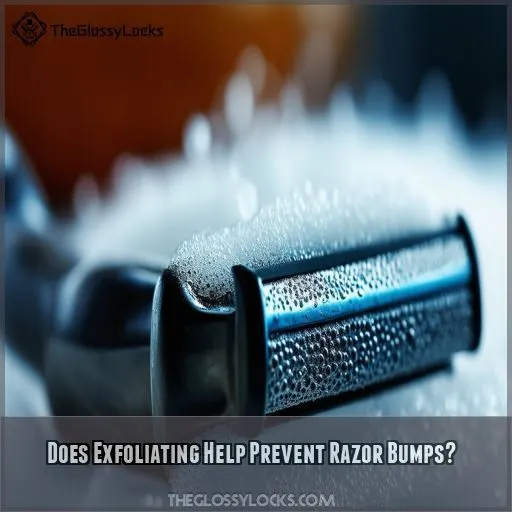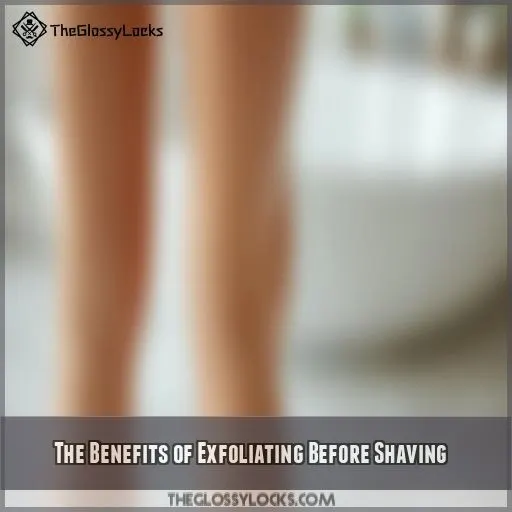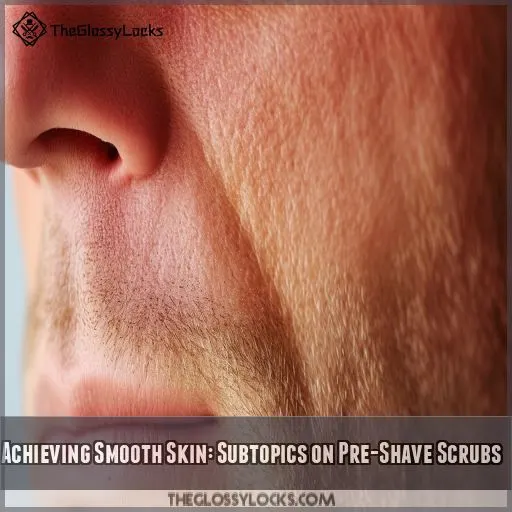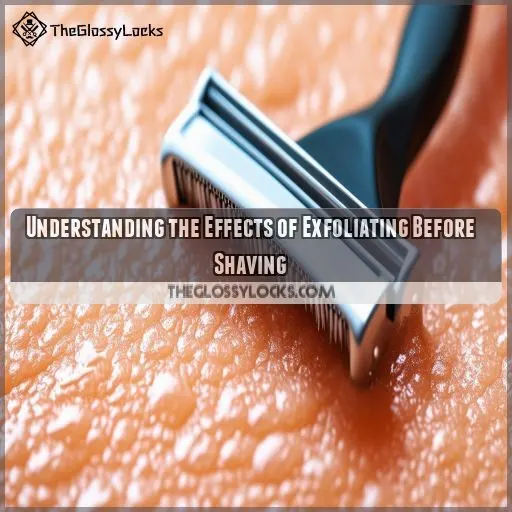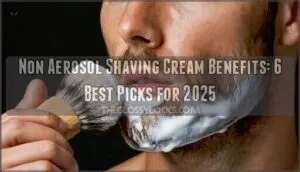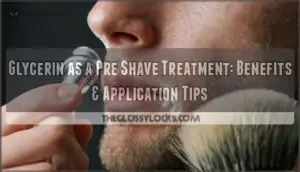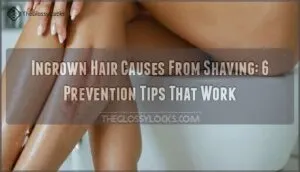This site is supported by our readers. We may earn a commission, at no cost to you, if you purchase through links.
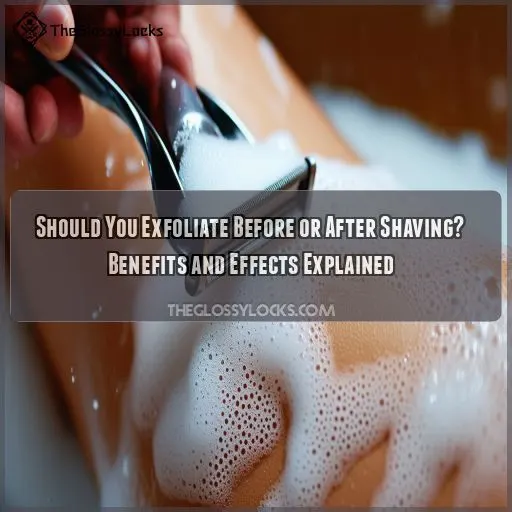 Ever wondered if you should exfoliate before or after shaving? Proper exfoliation can revolutionize your shaving routine, preventing razor bumps and ensuring a silky smooth finish.
Ever wondered if you should exfoliate before or after shaving? Proper exfoliation can revolutionize your shaving routine, preventing razor bumps and ensuring a silky smooth finish.
Removing dead skin cells is the game-changer for unclogging pores, prepping your skin, and reducing irritation for a closer, more comfortable shave. Understanding the best time to exfoliate will help you achieve that desired smooth skin.
This guide will explain the benefits and effects of exfoliating before and after shaving, providing simple steps for improved skincare results.
Table Of Contents
- Key Takeaways
- Should You Exfoliate Before or After Shaving?
- Does Exfoliating Help Prevent Razor Bumps?
- Shaving Before or After Using Body Wash: What’s Best?
- The Benefits of Exfoliating Before Shaving
- Achieving Smooth Skin: Subtopics on Pre-Shave Scrubs
- Maximizing the Benefits: Subtopics on Exfoliating After Shaving
- Understanding the Effects of Exfoliating Before Shaving
- Exploring the Impact of Exfoliating After Shaving
- Frequently Asked Questions (FAQs)
- Should you exfoliate or shave first?
- Does exfoliating help with razor bumps?
- Should you shave before or after body wash?
- Should I exfoliate before or after showering?
- How long should you soak before shaving?
- How often should you exfoliate?
- Can I use body wash before shaving?
- What are the signs I need to exfoliate?
- How do I choose the right exfoliator?
- Conclusion
Key Takeaways
- Prepare your skin for a shaving masterpiece! Exfoliate before shaving to pave the way for a smoother, irritation-free shave. It’s like giving your skin a VIP treatment before the main show.
- Bid farewell to ingrown hairs and razor bumps by exfoliating before shaving. Clear away dead skin cells to create a clean canvas for your razor to glide effortlessly, like a hot knife through butter.
- Make exfoliating before shaving your skin’s best friend. Unclog pores, promote hair growth, and reduce irritation for a shaving experience that leaves your skin feeling as soft as a cloud.
- Maximize the benefits by exfoliating both before and after shaving. Remove dead skin pre-shave, then reveal smoother, radiant skin post-shave. It’s like hitting the skincare jackpot—smooth skin all the way!
Should You Exfoliate Before or After Shaving?
Exfoliating and shaving are two key steps to achieving smooth, healthy skin. So, which comes first? The answer is clear: exfoliate before shaving. Here’s the lowdown:
Exfoliating before shaving prepares the skin for a close and comfortable shave. It clears away dead skin cells and unclogs pores, promoting hair growth and reducing ingrown hairs. This simple step leaves your skin smooth and soft.
Now, let’s examine some skin prep and shaving techniques to maximize your exfoliating and shaving routine.
Does Exfoliating Help Prevent Razor Bumps?
- Unclogs Hair Follicles: Exfoliating removes dead skin cells, clearing the way for hair to grow freely without becoming ingrown.
- Smooths Skin: By sloughing off dead skin, exfoliation creates a smoother surface for shaving, reducing the risk of razor bumps.
- Reduces Irritation: Pre-shave exfoliation minimizes skin irritation, a key factor in the development of razor bumps.
- Enhances Skincare Absorption: Exfoliation allows skincare products, like moisturizing creams, to absorb more effectively, keeping skin healthy and reducing bump-causing dryness.
Shaving Before or After Using Body Wash: What’s Best?
Shaving and body wash—sequence simplified. A clear-cut solution to the order of your shower rituals: shave, then cleanse. Here’s a concise lowdown:
For the best results and smooth skin, always shave first. This guarantees you start with product-free skin, giving a closer shave and preventing irritation. Think of it as a fresh canvas for your razor, free of body wash residue. A clean start for your skin before applying any products.
Keep it simple, and happy shaving!
The Benefits of Exfoliating Before Shaving
Exfoliating before shaving is essential for achieving smooth, irritation-free skin. It removes dead skin cells, allowing for a closer shave and reducing the risk of ingrown hairs.
Exfoliating Before Shaving
Exfoliating before shaving is a smart move; it gives your skin a fresh start. By removing dead skin cells, you’re creating a smooth canvas for shaving and doing much more. You’re also preventing clogged hair follicles and those pesky ingrown hairs. Think of it as a deep clean, revealing fresh, healthy skin.
This pre-shave exfoliation step is key to achieving that desired smooth, bump-free shave.
Skin Prep
Before you even think about shaving, you need to prep your skin. It’s like laying the foundation for a house—get it right, and the rest will follow.
Start by soaking in a warm bath or shower to open your pores and soften your hair. Then, apply a soothing shower mousse to create a smooth surface for your razor to glide over.
Think of it as the ultimate prep for gentle shaving.
Benefits of Exfoliation
Exfoliating before shaving is a game-changer for skin health and achieving that coveted silky-smooth-legs status. It buffs away dead skin cells, unclogs pores, and prevents ingrown hairs.
This essential step creates the perfect canvas for shaving, allowing your razor to glide effortlessly and reducing irritation. Regular exfoliation also keeps skin soft and radiant, enhancing your post-shave routine and overall skin appearance.
Achieving Smooth Skin: Subtopics on Pre-Shave Scrubs
Achieving smooth skin starts with using the right pre-shave scrubs like Smooth Legend, Bubble Butt Jelly, Moon Rocks Whipped, and Barbie Smooth. Each offers unique benefits to exfoliate and prepare your skin for a closer, irritation-free shave.
Smooth Legend Pre-Shave Scrub
Smooth Legend Pre-Shave Scrub is your fast track to legendary status in the quest for smooth skin. Here’s why integrating it into your pre-shave routine is advantageous:
- Scrub benefits: This scrub is an effective weapon in your quest for smooth skin, efficiently sloughing away dead cells and keeping pores clear.
- Skin renewal: Consistent use stimulates skin renewal, imparting a vibrant, healthy radiance.
- Exfoliating razor prep: By eliminating dead skin cells, this scrub facilitates a seamless razor glide, minimizing irritation for an enhanced shaving experience.
- Silky smooth skin: Achieve touchably soft and silky smooth skin that looks and feels incredible.
- Pre-shave perks: Incorporating a scrub into your pre-shave routine boosts skin health, diminishes ingrown hairs, and prepares the ideal base for a close and comfortable shave.
Bubble Butt Jelly Body Scrub
For a fun and effective pre-shave scrub, try the Bubble Butt Jelly Body Scrub. This unique jelly scrub provides a gentle yet thorough exfoliation, leaving your skin feeling soft and smooth. Here’s a breakdown of its benefits:
| Feature | Description |
|---|---|
| Jelly Texture | Provides a fun, sensory experience while gently buffing the skin. |
| Natural Ingredients | Contains natural exfoliants and skin-softening agents for effective body exfoliation. |
| Clogged Pores | Helps unclog pores and prevent ingrown hairs, setting the stage for a smooth shave. |
The jelly scrub’s unique texture and natural ingredients offer a sensory experience, ensuring your skin is prepped for a close and comfortable shave.
Moon Rocks Whipped Body Scrub
For the ultimate pre-shave scrub, try Moon Rocks Whipped Body Scrub. This whipped creation delivers:
- Natural ingredients to enhance skin radiance.
- Exfoliating properties to gently remove dead skin cells and prepare the skin for a close shave.
- A calming and hydrating formula that guarantees skin health and provides a smooth base.
- A unique, whipped texture for an indulgent and sensory experience.
Barbie Smooth Scrub
Get that smooth, flawless skin with Barbie Smooth Scrub. This scrub formula packs a punch with its exfoliation power, leaving your skin feeling refreshed and healthy.
| Feature | Description |
|---|---|
| Skin Benefits | Removes dead skin cells and unclogs pores for a deeper cleanse. |
| Smooth Results | Prepares skin for shaving, ensuring a closer and smoother shave. |
| Key Ingredients | Natural exfoliants and nourishing moisturizers for soft, radiant skin. |
| Usage | Massage gently onto damp skin before shaving for best results. |
| Shaving Advice | Always use a sharp razor and shave in the direction of hair growth. |
Maximizing the Benefits: Subtopics on Exfoliating After Shaving
Exfoliating after shaving can maximize the benefits for your skin. Try using a vegan collagen booster body polish or a gold black soap to reveal smoother, more radiant skin.
Vegan Collagen Booster Body Polish
Vegan Collagen Booster Body Polish is a fantastic option for your post-shave routine. This body polish is designed to maximize the benefits of exfoliating after shaving, leaving your skin feeling smooth and looking radiant.
The natural ingredients in this polish boost collagen production, enhancing skin elasticity and firmness. It’s a powerful way to promote skin health and achieve a youthful appearance.
Gold Black Soap
Gold Black Soap offers a lavish cleansing experience with its rich, indulgent lather, leaving your skin feeling pampered and nourished. This superior soap elevates your self-care ritual, providing a sensory treat with each use. The soap’s elegant black color gives your skincare routine a touch of sophistication, and its moisturizing qualities guarantee that your skin remains hydrated and healthy.
Gold Black Soap is ideal for those seeking a touch of indulgence without compromising on skin health. It’s especially beneficial as part of your post-shave routine, leaving your skin feeling soft, smooth, and revitalized.
Understanding the Effects of Exfoliating Before Shaving
Understanding the effects of exfoliating before shaving is key to achieving smooth, healthy skin. Exfoliating is like creating an ideal base for shaving by stripping away dead skin cells and clearing pores. This helps hair grow without obstacles and lowers the chance of ingrown hairs.
It’s an important step in your skin prep routine, allowing for a closer and smoother shave. Think of it as a reset for your skin, bringing forward newer and healthier skin. So, don’t be afraid to scrub and set the stage for shaving success!
Exploring the Impact of Exfoliating After Shaving
Exfoliating after shaving can be beneficial, but it’s important to be cautious to avoid skin irritation. It helps remove any remaining dead skin cells, reducing the chances of clogged pores and ingrown hairs. This step maintains your skin’s smoothness and health.
However, it’s essential to select a gentle technique, especially if your skin is sensitive. Go for a gentle exfoliator with natural ingredients, and remember to apply a good moisturizer afterward to calm and protect your skin.
Frequently Asked Questions (FAQs)
Should you exfoliate or shave first?
Exfoliate, then shave. Exfoliating first removes dead skin cells, allowing for a closer, more comfortable shave.
Does exfoliating help with razor bumps?
Yes, exfoliating helps prevent razor bumps by removing dead skin cells and softening facial hair. It also deep-cleans your pores of bacteria and oily buildup, reducing the risk of razor burn.
Should you shave before or after body wash?
Shaving after a body wash is recommended. Warm water and steam open your skin’s pores, softening hair follicles, and making for a closer, more comfortable shave.
Should I exfoliate before or after showering?
You should exfoliate after showering. It’s better to exfoliate after using haircare or other shower products, and when you can use cool water. It comes down to personal preference, but using cool water and exfoliating after showering is the best way to unclog pores and leave your skin smooth and glowing.
How long should you soak before shaving?
Soak the area you plan to shave for at least three minutes using warm water. This softens the skin and hair, making it easier to cut.
How often should you exfoliate?
It depends on your skin type. Generally, two to three times a week is recommended. If you have oily skin, you can exfoliate up to four times a week. If you have dry or sensitive skin, once a week or less is enough.
Can I use body wash before shaving?
You might be wondering if you can use body wash before shaving. Well, it’s totally up to you! Some people prefer to wash first, as it can help to clean and exfoliate the skin, making shaving easier.
However, a dermatologist recommends only using body wash on the legs if they’re visibly dirty, as it can cause dryness and damage without offering any real benefits.
What are the signs I need to exfoliate?
You may need to exfoliate if you have acne breakouts, dry skin, or flaking skin. A dermatologist can offer personalized advice on the best exfoliation method for your skin type.
How do I choose the right exfoliator?
When choosing an exfoliator, opt for a gentle chemical exfoliator with alpha-hydroxy acid (AHA) or beta-hydroxy acid (BHA). Avoid harsh physical scrubs, especially for your face, as the skin there’s thinner and more sensitive.
Conclusion
Whether you’re a shaving enthusiast or a skincare aficionado, understanding the ins and outs of exfoliating before or after shaving is key.
This guide has clarified the mysteries of this skincare ritual, equipping you with insight to achieve that desired silky smooth skin.
By following the simple steps provided, you can now confidently decide when to exfoliate, knowing the benefits and effects on your skin.
Transform your shaving routine, say goodbye to razor bumps, and embrace the glow of healthy, radiant skin. Now you’re informed about exfoliating before or after shaving.

